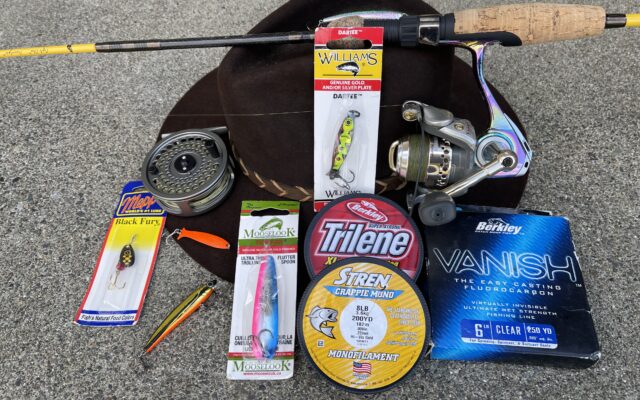
I guess it’s no surprise that I’m a devout fly fisherman. No matter what species, fresh or salt water; or what state, country or continent’s river, lake, stream or ocean I‘m visiting, I’d rather be casting a fly rod with some sort of feathered creation at the end of my line and leader.
Apparently my obsession has slanted my articles toward lots of information about dry, wet and streamer flies, as well as info about favorite trout, salmon, togue, bass and muskie patterns and even saltwater options.
A handful of emails from faithful readers, as well as two recent face-to-face encounters at a restaurant and the grocery store, kindly wondered if I mightn’t suggest some favorite lures. In all honesty, I do use lures fairly frequently, especially in conjunction with flies when trolling multiple rods and also casting and trolling for bass and muskie. The word “lure” can actually refer to any type of bait used for fishing, even a fly, but in Maine the word is generally meant to describe a shiny or colorful piece of metal in a wide array of weights, shapes and sizes.
Another name for artificial baits, older anglers may still use the term “plug” to describe plastic, cork, or wooden formed or carved baits, especially floating versions. Rapala and Rebel each manufacture a wide variety of floating or shallow diving baits that I refer to as plugs. Some modern plugs are built hollow so plastic or metal pellets can be implanted to either add weight for deeper diving or to rattle to attract attention.
With May being prime time for ice out on Aroostook lakes, this is the perfect opportunity to discuss proven plugs and legendary lures for spring trolling.

There are few lures as dependable for trout fishing as the the original Eppinger red and white Dardevle. (Courtesy of Bill Graves)
Most fishermen have a favorite lure or two, and will be quick to explain they seldom fail to catch fish on these special baits. What many overlook is the fact that those couple of baits are the only ones used 90 percent of the time. No one lure is the best day after day; weather and water conditions change regularly, and so do the fish. I really love lobster, but I don’t want it every meal every day. I’m a short-term believer, a quick-change artist, if you will; any lure not producing a strike within 45 to 60 minutes is changed.
Usually you’ll find one that works eventually, and you certainly can’t get less action switching baits.
Among my top six plugs is a size 7 floating Rapala in fluorescent orange, silver/black or perch colored. It runs 2 to 3 feet deep when trolled and works on trout, salmon, togue and bass. A red-and-white Dardevle and an Al’s goldfish were created about 75 years ago in the early 1950s and are still consistent fish takers. They each come in various sizes and weights. The long, heavy models are for deep fishing large gamefish on fast, heavy current rivers, deep lakes or on the ocean.
There are several color variations to both the original Eppinger Dardevle and Al’s goldfish, but in my experience the original red and white strips and the original embossed gold work best. On occasion I’ve caught a few trout on the silver Al’s goldfish. For both lures the 1/8 or 3/16 ounce, 2-1/2 inch length models offer steady action on Crown of Maine waterways.
What Aroostook tackle box would be complete without at least a couple of Mooselook wobblers from the company’s huge variety of options? Created in 1938 on Mooselookmeguntic Lake in Maine by John A. Greene, the lures’ popularity and propensity to catch fish have ranked far and wide over North America. Of the 32 currently available color combos, I stick to my roots, having successfully used either the original chrome or the pounded copper finish for decades. The medium size is my favorite at 3 1/2 inches and a quarter of an ounce.

Every tackle box needs a wide selection of lures. Shown are a few of the author’s favorites in a wide range of shapes, sizes and colors. (Courtesy of Bill Graves)
Another name for a lure is a spoon, basically because a century or so ago some obscure angler actually created a successful bait by attaching hooks to the cupped blade of a kitchen utensil. For my money there are no better, more consistent fish catchers than Sutton Spoons. I particularly like the size 6, 8, and 81 in silver or silver and bronze on opposite sides. There are actually 27 sizes and shapes and they are difficult to find in most sporting goods stores, so buy several when you have an opportunity.
My sixth selection is based more on the experience and expertise of top-rate anglers and close friends, Roger Shaw and Tom Tardiff. Both agreed with most of my own lure choices and then gave very high recommendations to a Panther Martin, particularly the yellow with red spots. Many fishermen refer to Panther Martin as spinners or spinner baits, but as we discussed, a lure by any other name is still a lure.
There you have it. Of the thousands of metal, plastic and wooden lures and plugs in myriad shapes, sizes and colors, those are my favorite half dozen. If you can’t catch fish, especially trout and salmon, anywhere in Maine with this lineup, it may be time to take up another pastime.







